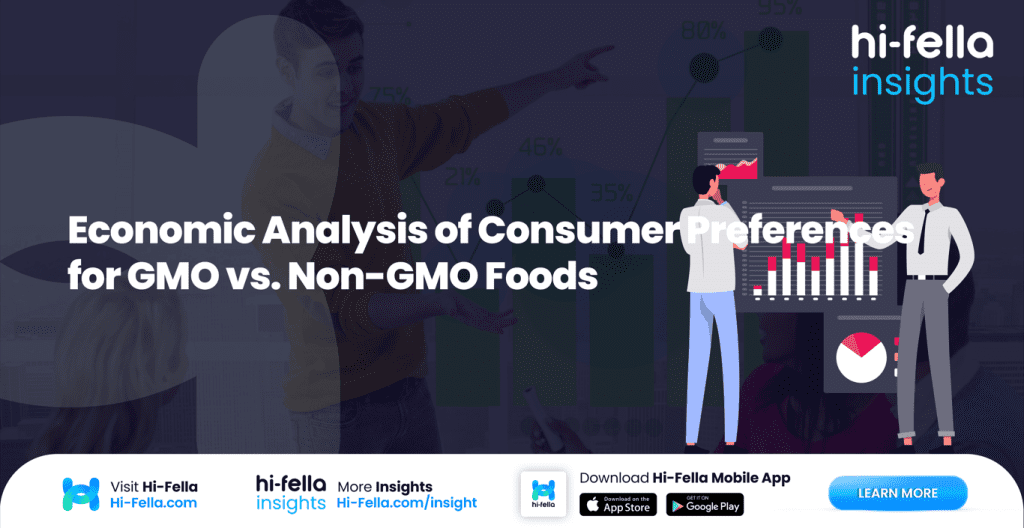The GMO debate is no longer confined to science journals and activist circles—it’s a business issue, a branding challenge, and a market differentiator. In today’s fragmented food economy, consumer preferences around genetically modified organisms (GMO) and non-GMO foods are shaping pricing, product development, trade strategy, and shelf space allocation.

So how much does consumer opinion actually influence market outcomes? And more importantly: what are the economic implications for food producers and suppliers navigating these two camps?
Let’s explore the business side of the GMO vs. non-GMO divide, looking at consumer demand trends, pricing behaviour, production costs, and export opportunities.
What Do GMO and Non-GMO Really Mean?
Before diving into pricing, supply chains, or trade policy, it’s worth clarifying what we mean when we say GMO and non-GMO—because the terms often get thrown around without much context.
GMO stands for Genetically Modified Organism. In the context of food, it refers to plants (and sometimes animals or microbes) that have been genetically engineered in a lab to express traits that don’t naturally occur through traditional breeding. For example, a corn variety might be modified to resist specific pests or tolerate herbicides, which can improve yields and reduce the need for chemical sprays. GMO crops have been widely adopted in major agricultural markets like the United States, Brazil, and Argentina.
On the flip side, non-GMO foods are those that haven’t been altered using genetic engineering techniques. These foods are often perceived as more natural or closer to how they’ve historically been cultivated. It’s important to note that non-GMO doesn’t necessarily mean organic or chemical-free—it simply means the genetic material hasn’t been manipulated in a laboratory setting.
From a scientific standpoint, the global consensus—including institutions like the WHO and FDA—is that GMO foods are safe to eat. But from a consumer psychology standpoint, many shoppers remain sceptical, particularly in markets where food choices are increasingly tied to personal values, environmental concerns, or lifestyle branding.
That perception gap is where the economics kick in. Regardless of the science, consumers who believe non-GMO is “better” often treat it as a premium feature—one they’re willing to pay extra for. And that creates pricing power, product differentiation, and trade opportunities for brands that can validate and deliver on that label.
The Psychology Behind the Preference
Consumer preferences for non-GMO foods aren’t just about nutrition—they’re driven by a combination of perception, trust, and values. Many consumers associate “non-GMO” with being more natural, healthier, and environmentally friendly—even if the science doesn’t conclusively support those beliefs.
This perception is especially strong in high-income markets like the United States, Germany, Japan, and South Korea. In these regions, consumers are willing to pay more for labels like “non-GMO,” “organic,” and “clean label”—not necessarily because they understand the genetic science behind it, but because the label signals quality, purity, and ethical sourcing.
This is important economically. A preference doesn’t need to be “rational” to shape the market. If people believe non-GMO is better and are willing to pay a premium, then it becomes a differentiated product with higher perceived value—and that’s the kind of leverage suppliers and exporters need to understand.
Price Elasticity and Willingness to Pay
Studies consistently show that a subset of consumers is willing to pay a premium for non-GMO foods—but the size of that subset varies by region, income level, and product category.
For instance, research in the U.S. suggests that consumers are willing to pay 10–20% more for non-GMO labelled products, particularly in high-trust categories like baby food, dairy, and cereal. However, in price-sensitive markets or commodity categories like cooking oil or soy-based snacks, this premium shrinks or disappears entirely.
This variation matters for manufacturers and exporters. If you’re operating in a region with low willingness to pay for non-GMO products, shifting to non-GMO inputs may reduce margins without increasing revenue. On the other hand, in premium markets or high-sensitivity categories, the price elasticity is favourable—and going non-GMO can be a strategic move to unlock premium shelf positioning and brand loyalty.
Cost of Production and Certification
Switching to non-GMO isn’t just about planting different seeds—it requires a complete overhaul of supply chain management. This includes:
- Sourcing certified non-GMO raw materials
- Preventing cross-contamination in processing facilities
- Maintaining audit trails and documentation
- Undergoing third-party verification
These steps add costs—often 5–15% more than conventional GMO-based production. In some cases, suppliers must deal with reduced yield and higher pest management costs, especially for crops like corn and soy.
That means non-GMO only becomes economically viable if there’s a price premium on the sales side. Without that premium—or without access to buyers who value the label—the economics of non-GMO can become unsustainable.
Export Dynamics: GMO Policies Shape Market Access
The global food trade is deeply influenced by national policies around GMOs. While the U.S., Brazil, and Argentina are major producers of GMO crops, the European Union, China, and Russia maintain tighter restrictions, or even bans, on GMO imports for human consumption.
This creates a trade segmentation in global supply chains. Exporters looking to enter GMO-sensitive markets must either provide certified non-GMO products or face import barriers. Conversely, exporters targeting GMO-tolerant markets can scale with lower production costs and fewer documentation demands.
If you’re an export-oriented food brand, understanding market-specific GMO acceptance is key to positioning your product correctly—and avoiding shipment rejections, regulatory fines, or consumer backlash.
Retailer and Brand Influence
In many cases, it’s not just the end consumer who dictates preference—it’s the retail gatekeepers. Supermarket chains, especially in developed markets, are increasingly setting their own standards around GMOs.
Retailers like Whole Foods, Aldi, and Carrefour have pushed for clearer labelling or even non-GMO product lines. Large food brands are responding by reformulating products or offering dual-label lines (GMO and non-GMO) to serve different market segments.
For suppliers, this creates pressure—but also opportunity. Being non-GMO certified opens doors to premium buyers, retail chains, and food service clients who are looking for differentiated inventory to meet consumer trends.
Emerging Markets: GMO Acceptance Is Higher, But Shifting
In emerging markets across Southeast Asia, Latin America, and parts of Africa, GMO acceptance is generally higher—mainly due to price sensitivity and lower awareness. However, urban consumers in these regions are starting to mirror Western trends, especially with the rise of e-commerce and digital food education.
This means demand for non-GMO products is growing—but still concentrated in specific demographics, such as upper-middle-income households or niche health-conscious segments.
For regional suppliers, this creates a chance to build dual offerings: one for mass market, price-driven buyers, and another for urban, quality-driven consumers willing to pay for non-GMO labels.
Strategic Takeaways for Suppliers and Exporters
The GMO vs. non-GMO debate is not just ideological—it’s deeply economic. Here’s what smart food businesses need to consider:
- Consumer preferences matter, but only when backed by willingness to pay
- Production costs are higher for non-GMO, so pricing must reflect it
- Market access and compliance vary across regions—do your homework
- Retailers are powerful influencers of labelling trends
- Dual-strategy models can work in split markets (GMO for mainstream, non-GMO for premium)
Ultimately, the right move depends on your market, product category, and export ambitions. But whichever side of the GMO divide you land on, make sure it’s a business decision rooted in economics—not emotion.
Ready to Navigate the GMO Trade Landscape?
If you’re planning to launch a non-GMO line, explore international buyers who prefer clean-label products, or showcase your certified inventory in the right market—hi-fella is your platform.
With access to international exhibitions, smart matchmaking tools, and export-import support tailored to food businesses, hi-fella helps you align your supply strategy with global demand. Whether you’re trading corn, chocolate, or coconut water, understanding consumer preferences is the first step—and executing with the right platform is the next.
Trade smart. Position clearly. Grow globally—with hi-fella.







